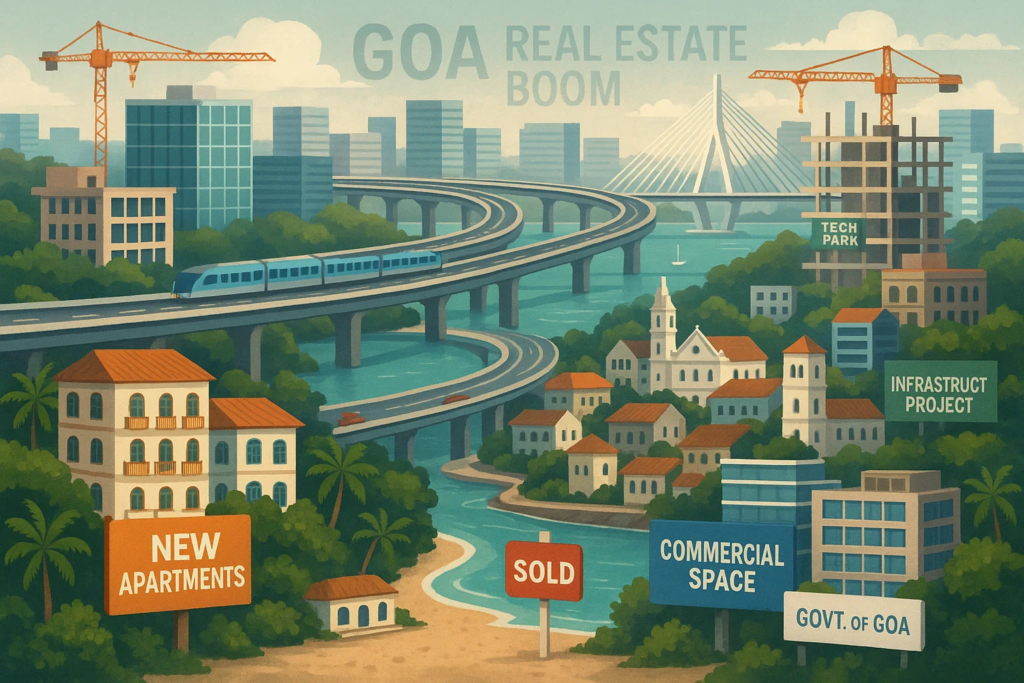Government-driven development is emerging as a key catalyst for Goa’s real estate transformation. From new airports and expressways to smart policies and public-private partnerships, the state is strategically leveraging infrastructure, regulatory reforms, and land monetization to reshape the property landscape. Here’s how these initiatives are influencing the market dynamics in Goa.

1. Infrastructure Catalysts
Expansion of Mopa (Manohar) International Airport
Since its launch in January 2023, Mopa Airport has significantly improved Goa’s air connectivity. This new airport has attracted NRIs, vacation home seekers, and real estate developers, especially in North Goa and adjacent regions. It is rapidly becoming a hub for tourism, trade, and residential demand.
Road and Expressway Projects
- The proposed Shaktipeeth Expressway, connecting Nagpur to Goa, is expected to reduce travel time drastically. This will enhance the appeal of interior and border regions of Goa for real estate development.
- Infrastructure improvements like the Atal Setu bridge over the Mandovi River have improved urban mobility and encouraged real estate development in surrounding areas.
Port Modernization and Industrial Growth
Ongoing upgrades to Goa’s ports and industrial estates, including the Mormugao Port and other logistic hubs, are improving the region’s business ecosystem. This commercial push is drawing industrial and commercial real estate investments across Goa.
2. Unlocking and Monetizing Government Land
Public-Private Partnership (PPP) Initiatives
Goa’s Housing and Rehabilitation Board is actively collaborating with developers to unlock unused government land. Projects are underway in areas like Vasco, Baina, and Colvale, with plans for residential, commercial, and mixed-use developments. These initiatives are widening the supply pipeline and improving regional balance in development.
Orchard Land Redevelopment
An innovative model encourages private orchard landowners to partner with the government. The scheme allows owners to retain part of the developed plots, while the remaining is sold affordably to Goan residents. This is increasing land supply for housing in a controlled, community-driven manner.
3. Urban Planning and Regulatory Reforms
Budget 2025 Housing Reforms
Recent reforms proposed in the state budget include:
- Simplification of housing permission processes
- Relaxed timelines for infrastructure tax payments
- Strengthened planning oversight by the Town and Country Planning (TCP) department
- Introduction of carrying-capacity-based studies to manage construction density
These reforms are designed to fast-track construction while ensuring sustainable urban planning.
Heritage Conservation Initiatives
The government has introduced a sustainable heritage policy that includes financial support, legal assistance, and regulatory flexibility to conserve old Goan homes. A dedicated committee is being set up to address issues faced by owners of private heritage properties, offering a framework for responsible preservation.
Legalizing Informal Housing
A new bill is being prepared to legalize homes built on government or comunidade land. This aims to regularize thousands of properties, increasing formal housing stock and bringing more residents into the regulated property system.
Also Read:
Goa Real Estate Prices 2025–2026
How MOPA Airport’s Impact on Real Estate in Goa
4. Impacts on Property Market Trends
Rise in Circle Rates and Market Transparency
The government has increased base land rates significantly across districts.
- In Salcete, Mormugao, and Tiswadi, rates increased by up to 450%
- In Bardez and Pernem, increases range between 130% to 200%
These changes align registry values closer to actual market prices, which improves transaction transparency and increases government revenues through stamp duty.
Growth in Premium and Rental Housing
The demand for high-end villas, serviced apartments, and rental-friendly properties is booming. North Goa areas like Siolim, Candolim, and Calangute have seen capital appreciation of over 150% in the past five years. Rental yields in these areas are also robust, with returns ranging from 6% to 10% annually.
Affordable and Sustainable Housing
Government schemes are also driving affordable housing. Through projects under GHB and slum redevelopment efforts, the aim is to offer quality housing for locals while also maintaining ecological balance through green building codes and infrastructure norms.
5. Challenges and Balancing Acts
Affordability vs. Investment Demand
While infrastructure boosts demand and land prices, there is concern about whether local buyers can still afford homes. Government intervention will be required to ensure that development does not lead to exclusion.
Environmental and Ecological Concerns
Massive projects like expressways, industrial corridors, and townships may affect Goa’s fragile ecological zones. There have been strong public movements in the past to protect forests, biodiversity, and water bodies from unchecked development.
Cultural Preservation and Local Sentiments
As real estate in Goa attracts big developers from outside the state, there is growing concern over cultural dilution. Locals are increasingly calling for policy safeguards that prioritize Goans in housing schemes and limit aggressive commercialisation.
6. Outlook
| Development Factor | Impact on Real Estate |
|---|---|
| New Airport and Expressways | Expands demand for vacation and luxury homes |
| Govt Land Monetization | Increases housing supply and PPP involvement |
| Regulatory Reforms | Faster approvals, more planned development |
| Rate Adjustments | Improves transparency but raises purchase cost |
| Heritage & Sustainability Policies | Supports long-term growth with cultural value |
Goa’s property market is on the cusp of significant transformation, with government-led development acting as a driving force. Infrastructure upgrades, policy reforms, and land unlock initiatives are set to shape the next decade of real estate growth.
However, the true measure of success will lie in how well the state balances growth with sustainability, inclusivity, and cultural preservation. Developers, policymakers, and citizens must work together to ensure that Goa remains not only a profitable destination but also a livable and lovable one.